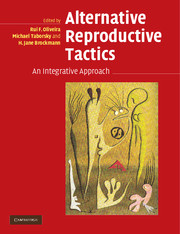Book contents
- Frontmatter
- Contents
- List of contributors
- Preface
- 1 The evolution of alternative reproductive tactics: concepts and questions
- PART I ULTIMATE CAUSES AND ORIGINS OF ALTERNATIVE REPRODUCTIVE TACTICS
- PART II PROXIMATE MECHANISMS OF ALTERNATIVE REPRODUCTIVE TACTICS
- 5 The roles of genes and the environment in the expression and evolution of alternative tactics
- 6 Neuroendocrine mechanisms of alternative reproductive tactics: the chemical language of reproductive and social plasticity
- 7 Hormones and alternative reproductive tactics in vertebrates
- PART III TAXONOMIC REVIEWS OF ALTERNATIVE REPRODUCTIVE TACTICS
- PART IV EMERGING PERSPECTIVES ON ALTERNATIVE REPRODUCTIVE TACTICS
- Index of species
- Subject index
- References
6 - Neuroendocrine mechanisms of alternative reproductive tactics: the chemical language of reproductive and social plasticity
Published online by Cambridge University Press: 10 August 2009
- Frontmatter
- Contents
- List of contributors
- Preface
- 1 The evolution of alternative reproductive tactics: concepts and questions
- PART I ULTIMATE CAUSES AND ORIGINS OF ALTERNATIVE REPRODUCTIVE TACTICS
- PART II PROXIMATE MECHANISMS OF ALTERNATIVE REPRODUCTIVE TACTICS
- 5 The roles of genes and the environment in the expression and evolution of alternative tactics
- 6 Neuroendocrine mechanisms of alternative reproductive tactics: the chemical language of reproductive and social plasticity
- 7 Hormones and alternative reproductive tactics in vertebrates
- PART III TAXONOMIC REVIEWS OF ALTERNATIVE REPRODUCTIVE TACTICS
- PART IV EMERGING PERSPECTIVES ON ALTERNATIVE REPRODUCTIVE TACTICS
- Index of species
- Subject index
- References
Summary
CHAPTER SUMMARY
The wide range of variation in reproductive tactics displayed among teleost fishes has provided a rich source of natural experiments for investigating the neural mechanisms of alternative reproductive tactics (ARTs). These studies have mainly focused on identifying the location and extent of neuropeptide-containing cells in the forebrain's preoptic area (POA), in part, because of the well-established influence of these neurons on reproductive mechanisms. We first review the ARTs of teleost species that have served as model systems for investigating the neural mechanisms of reproductive plasticity and then the general organization of the POA of vertebrates. Comparative surveys then show how life-history trajectories and reproductive tactics vary with inter- and intrasexual dimorphisms in the size and number of POA neurons that synthesize either arginine vasotocin (AVT) or gonadotropin-releasing hormone (GnRH). The emerging evidence for the potential role of neurosteroids in mechanisms of reproductive plasticity inclusive of ARTs is then considered before concluding with a listing of a suite of neuroendocrinological traits that may provide proximate mechanisms essential to the widespread evolution of ARTs among teleost fish.
INTRODUCTION: DIVERGENT LIFE-HISTORY TRAJECTORIES
A major theme that continues to emerge from many studies of the neural mechanisms of ARTs is the uncoupling of gonadal and neurobiological traits that provides for the adaptable patterning of suites of mechanisms between alternative behavioral phenotypes (Bass 1992).
- Type
- Chapter
- Information
- Alternative Reproductive TacticsAn Integrative Approach, pp. 109 - 131Publisher: Cambridge University PressPrint publication year: 2008
References
- 12
- Cited by



